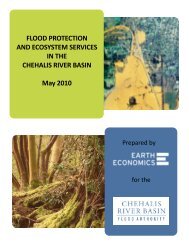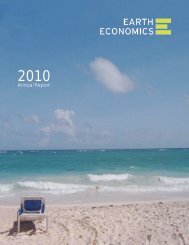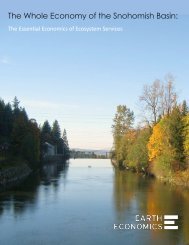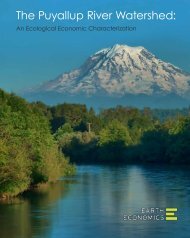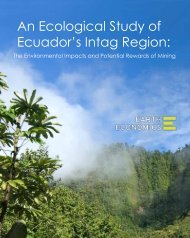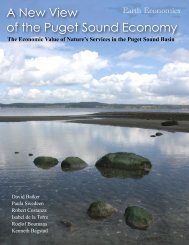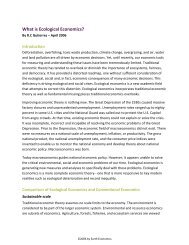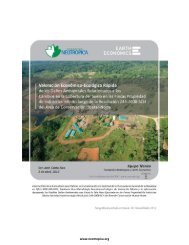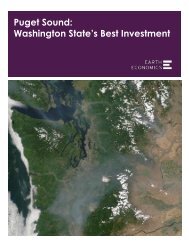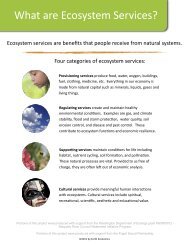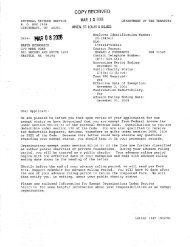The Spot Prawn Fishery: A Status Report - Earth Economics
The Spot Prawn Fishery: A Status Report - Earth Economics
The Spot Prawn Fishery: A Status Report - Earth Economics
You also want an ePaper? Increase the reach of your titles
YUMPU automatically turns print PDFs into web optimized ePapers that Google loves.
<strong>The</strong> <strong>Spot</strong> <strong>Prawn</strong> <strong>Fishery</strong>: A <strong>Status</strong> <strong>Report</strong><br />
WDFW Commission approved this recommendation<br />
in November 1997.<br />
<strong>The</strong> ECFA was enacted in 1990 to prevent habitat<br />
damage and conserve marine resources. <strong>The</strong> Act<br />
also protects the economic viability of fisheries<br />
through measures preventing overcapitalization.<br />
It authorizes the WDFW to limit the number of<br />
fishery permits issued annually for a period of<br />
up to five years. Furthermore, the permits issued<br />
are non-transferable and therefore unable to<br />
accumulate monetary value.<br />
An Industry Advisory Board was appointed in<br />
1998 according to ECFA guidelines. <strong>The</strong> Board’s<br />
mandate was to recommend to the WDFW the<br />
number of permits issued and the type of permit<br />
qualification requirements. This advice was incorporated<br />
into “a comprehensive regulatory package”<br />
that was approved by the Commission in<br />
December 1998, along with two fishery management<br />
policy statements. In January 1999, five trawl<br />
gear and ten pot gear permits were issued based<br />
on historical participation requirements. Later in<br />
1999, one of these trawl permits was converted<br />
to pot at the request of the fisher.<br />
An overall catch quota of 250,000 pounds was<br />
established and equally allocated to the two gear<br />
types. A trawl season of May 1 through November<br />
30 was instituted, and pot vessels were limited<br />
to 500 pots per vessel. Due to the fact that trawl<br />
gear is “widely reputed to cause inordinate adverse<br />
habitat impacts,” trawl gear was legally<br />
defined so as to prevent the use of “mud and tire<br />
and rockhopper gear” (WDFW 2001a). To avoid<br />
inter-jurisdictional conflict, WDFW and the<br />
Oregon Department of Fish and Wildlife (ODFW)<br />
outlined an agreement restricting fishers to their<br />
State’s waters unless they possess a fishing permit<br />
in the other State.<br />
Under this new management regime, 251,344<br />
pounds of spot prawns were caught in 1998, 86%<br />
landed by eight trawlers. Effort and catch both<br />
declined in 1999. About 101,326 pounds were<br />
landed, 95% landed by three trawl vessels.<br />
<strong>The</strong> Puget Sound <strong>Spot</strong> <strong>Prawn</strong> <strong>Fishery</strong><br />
<strong>The</strong> Puget Sound spot prawn fishery has a much<br />
longer and consistent catch history than the offshore<br />
fishery. Management of Puget Sound stocks<br />
is better established, especially in Hood Canal,<br />
Washington Coastal Commercial <strong>Spot</strong> <strong>Prawn</strong> <strong>Fishery</strong><br />
* Pounds caught off Washington landed in Oregon<br />
(Source: Lorna Wargo, WDFW—Montesano)<br />
29



